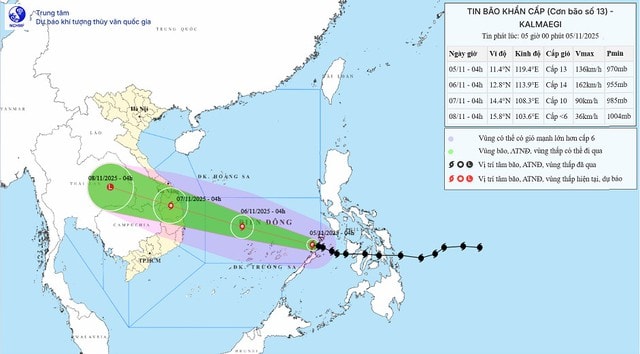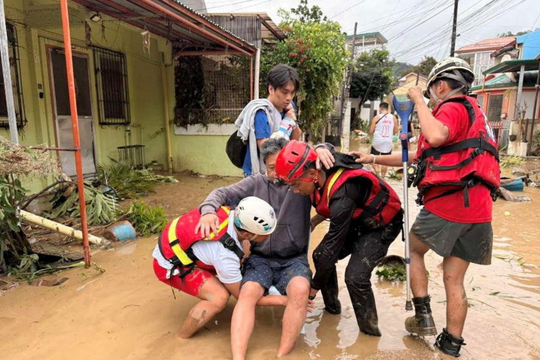Storm Kalmaegi: Forecast to make landfall in South Central Vietnam with wind gusts of level 17
Typhoon Kalmaegi is gradually strengthening as it moves rapidly into the East Sea, expected to make landfall in the South Central region on the night of November 6 - early morning of November 7, causing strong gusts of wind and widespread heavy rain.
According to the National Center for Hydro-Meteorological Forecasting, Typhoon Kalmaegi has officially entered the East Sea, becoming the 13th typhoon of 2025. The wind intensity is currently at level 14, gusting to level 16, and continues to strengthen as it approaches the central coast.
Storm Kalmaegi is forecast to move rapidly in the West - Northwest direction at a speed of about 25 km/h, with the possibility of making landfall in the South Central region around the night of November 6 to the early morning of November 7.
Director of the National Center for Hydro-Meteorological Forecasting, Mr. Mai Van Khiem, said that Typhoon Kalmaegi formed in the eastern Philippines, initially as a tropical depression but quickly intensified. Its fast movement speed and wide circulation structure make this storm one of the strongest since the beginning of the year.
Experts assess that Storm Kalmaegi has similar characteristics to two historical storms, Damrey (2017) and Molave (2020), which both made landfall in the South Central region, causing heavy damage.
Meteorological data shows that as Typhoon Kalmaegi approaches the coast, weakening factors such as cold fronts and wind shear are low. Therefore, the storm could maintain its strong intensity until it makes landfall, bringing violent wind gusts and extremely heavy rainfall.

Since the afternoon of November 4, although Typhoon Kalmaegi has not officially entered the East Sea, the forecasting agency has issued an emergency warning, requiring localities from Da Nang to Khanh Hoa to raise their vigilance level, deploy plans to evacuate people and protect boats from the strong storm circulation.
On the morning of November 5, Typhoon Kalmaegi continued to move into the middle of the East Sea, causing strong winds of level 7-8, then increasing to level 9-11; near the eye of the storm, strong winds of level 12-14, gusting to level 17. Waves are 5-7 m high, and up to 10 m high near the eye of the storm. It is expected that the Truong Sa archipelago will be the first to be affected by Typhoon Kalmaegi, with very strong winds and large waves, posing a danger to marine structures and ships operating offshore.
From early morning on November 6, the sea area from Da Nang to Khanh Hoa (including Ly Son Island) will have winds gradually increasing to level 6-7, then increasing to 8-11, the area near the storm center will reach level 12-14, gusting to level 17. The coastal area from Thua Thien Hue to Dak Lak will have waves 4-6 m high, the area near the center of Storm Kalmaegi will be up to 8 m high, causing rough seas and the risk of rising water from 0.3-0.6 m.
The meteorological agency warned that all vessels, anchorages and aquaculture areas in the area directly affected by Typhoon Kalmaegi should be evacuated or relocated immediately. Strong winds and large waves could pose a danger to fishing vessels, drilling rigs and coastal power systems.
Localities from Quang Tri to Khanh Hoa have been asked to deploy emergency response plans, brace houses, trim trees and prepare rescue forces. Storm Kalmaegi is expected to cause prolonged heavy rain, with rainfall of over 400 mm in some places, posing a high risk of flash floods and landslides in mountainous areas.
The circulation of Typhoon Kalmaegi is likely to cause very heavy rain in the area from Da Nang to Dak Lak on November 6-8, with total rainfall ranging from 200-400 mm, locally over 600 mm. The provinces from Khanh Hoa, Lam Dong to Hue will also have heavy rain of 150-300 mm, locally over 450 mm.
After making landfall, Typhoon Kalmaegi moved inland and gradually weakened, but its circulation could still bring rain until November 9 in the North Central region. The meteorological agency warned of a high risk of thunderstorms, tornadoes, lightning and strong gusts of wind both before and during the storm's landfall.
Typhoon Kalmaegi is considered one of the strongest and most dangerous storms of 2025. Central coastal provinces need to urgently deploy preventive measures, closely monitor the latest forecast bulletins and ensure absolute safety for people.




